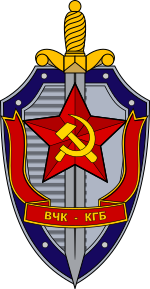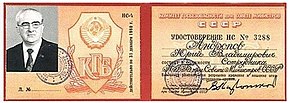KGB
| founding | Mar. 13, 1954 - Reorganization December 3rd, 1991 |
| country |
|
| Task of the authority | Intelligence service |
| Supervisory authority | Council of Ministers of the USSR |
| Emerged from | NKVD |
| Incorporated into | FSB |
| director | |
| Field Office | Lubyanka , Moscow |
| budget | secret |
| Employee | 480,000 (1991) |
| Sub-unit special unit | 12 |
| Website | |

The KGB (also: der KGB, , German Committee for State Security ) was the Soviet domestic and foreign secret service , which existed from 1954 to 1991. The full name of the KGB was Комитет государственной безопасности при Совете Министров СССР or Komitet gossudarstwennoi besopasnosti pri Sowjete Ministrów SSSR , in German State Security Committee at the Council of Ministers of the USSR (1954-1978) and KGB SSSR ( State Security Committee of the USSR , from 1978 to 1991 ). Belarus secret servicecontinues to be called KGB .
After the collapse of the Soviet Union, large parts of the KGB's structures were merged into the FSB and SWR, which still exist in Russia today .
history
In March 1946, all people's commissariats were renamed ministries, including the People's Commissariat for State Security (NKGB), which was subordinate to the NKVD and was now called the Ministry for State Security ( Ministerstwo gossudarstwennoj besopasnosti , MGB) and was the predecessor organization of the KGB.
The KGB was created in March 1954 from departments of the domestic secret service of the Ministry of Interior MWD and was directly subordinate to the Council of Ministers of the USSR . Its headquarters were in Moscow's Lubyanka . After the attempted coup in August 1991 , in which the then KGB chairman General Vladimir Kryuchkov was significantly involved, General Vadim Viktorovich Bakatin was commissioned to dissolve the authority. On November 6, 1991, the organization ceased to exist. Their tasks in Russia were taken over by the newly founded FSB (Федеральная служба безопасности) ( Federal Security Service ) and the foreign intelligence service SWR (Служба внешней разведки). In the independent Ukraine, the successor organization is called Security Service of Ukraine (Служба безпеки України). In Belarus the secret service is still called KGB (Belarus) .
assignment
The main tasks of the KGB were foreign espionage , counter-espionage , control of opponents of the regime within the Soviet Union and the security and guarding of members of the party and state leadership.
More than other secret services, the KGB relied on human sources ( human intelligence ), i.e. on knowledge obtained through its own agents or liaison officers, whereas the western opponents of the KGB also relied heavily on imaging , electronic and telecommunications intelligence .
organization
The KGB was divided into head offices and administrations. The most important were:
- First headquarters ПГУ , PGU (foreign intelligence )
was responsible for collecting secret information abroad. All KGB residencies at the Soviet embassies abroad as well as the espionage networks were subject to her. After the KGB was dissolved, it was transformed into an independent successor organization to the KGB alongside the FSB, the SWR (Foreign Reconnaissance Service).
- Second headquarters ВГУ , WGU
was responsible for counter-espionage and in this context for monitoring foreign tourists and diplomats in the Soviet Union. Before founding the Fifth Headquarters, it partly fulfilled its tasks.
- Third headquarters ТГУ , TGU ( armed forces )
dealt with military counter-espionage and political surveillance in the Soviet armed forces, including the military intelligence service GRU , which was under the General Staff and was independent. Nevertheless, the KGB also had employees in the armed forces who, according to their tasks, worked in the military service units in uniform, but were subordinate to the KGB and not to the military leadership (traditional designation "special department").
- Fourth administration (transport protection)
- Fifth Headquarters ("Political Police")
was founded in 1967 as a reaction to increasing "ideological problems" and took over the task of controlling the intellectual freedom of the population, especially the non-Russian minorities in the Soviet Union, the church, cultural and sporting life and the intelligentsia with the aim of combating dissidents . In Novaya Gazeta , Leonid Mlechin summed up the “ideological problem” in short: “As soon as fear disappears, the totalitarian regime will collapse”. As a result, there was increased media control and an increase in travel restrictions for Russians.
- Sixth administration
was entrusted with counter-espionage and industrial protection, including the control and surveillance of those working in the economy.
- Seventh administration
was responsible for observations and built appropriate technical surveillance equipment.
- Eighth head office
was responsible for telecommunications. She was responsible for the cryptography in all head offices, especially in connection with the KGB residences of the first head office abroad, and developed telecommunication equipment.
- Ninth administration
provided personal protection and servants for high-ranking officials and their families.
- Fifteenth Administration (Government Security Installations)
- Sixteenth administration ( SIGINT and communication monitoring)
- Headquarters of the border troops
was responsible for the border troops of the USSR since 1957 .
Chair of the KGB
- Ivan Alexandrovich Serov , March 13, 1954 to December 8, 1958
- Alexander Nikolayevich Schelepin , December 25, 1958 to November 13, 1961
- Vladimir Efimowitsch Semitschastny , November 13, 1961 to May 18, 1967
- Yuri Vladimirovich Andropov , May 18, 1967 to May 26, 1982
- Vitaly Wassiljewitsch Fedorschuk , May 26, 1982 to December 17, 1982
- Viktor Michailowitsch Tschebrikow , December 17, 1982 to October 1, 1988
- Vladimir Alexandrovich Kryuchkov , October 1, 1988 to August 22, 1991
- Leonid Vladimirovich Shebarschin , August 22, 1991
- Vadim Viktorovich Bakatin , 23 August 1991 to 6 November 1991
insignia
Komsomol KGB
Actual or supposed KGB agents
- Vladimir Vladimirovich Putin , current President of Russia.
- Alger Hiss is suspected of spying for the KGB, but this has never been proven to the last.
- Robert Hanssen provided the KGB with information about US counter-espionage from his position at the FBI .
- Aldrich Ames was a KGB mole in the CIA .
- George Blake
- Jack Barsky
- the so-called Cambridge Five (e.g. Kim Philby ) were among the most important and successful double agents during the Second World War
- Ahmad Mogharebi , Iranian general and Soviet spy. Executed on December 25, 1977 after being exposed by SAVAK agents of the Iranian secret service. Ahmad Mogharebi had worked for the KGB for more than 30 years before his exposure.
- Bogdan Nikolajewitsch Staschinsky , Soviet KGB agent, assassin and defector
James Jesus Angleton , head of the CIA counter-espionage, lived in constant fear that the KGB might install “ moles ” in two key positions: in its own department and its counterpart in the FBI. With two agents it would have been possible for the KGB to gain control or knowledge of actions against its own spies and thus to protect them. The counter-espionage also had the task of draining foreign intelligence sources, and moles at these positions would have become contact points for double agents. After Ames and Hanssen were exposed, Angleton's fears suddenly appeared well founded, having previously been thought to be slightly paranoid.
literature
- Christopher Andrew, Wassili Mitrochin: The Black Book of the KGB. Part 2: Moscow's Secret Cold War Operations. Propylaen Verlag, Berlin 2006, ISBN 3-549-07291-0 .
- Yevgenia Albaz: Secret Empire KGB. Grave digger of the Soviet Union. dtv, Munich 1992, ISBN 3-423-30326-3 .
- John Barron : KGB. Work and organization of the Soviet secret service in East and West. Scherz-Verlag, Bern / Munich 1973. (With a contribution by Alexander Solschenizyn )
- Hélène Blanc, Hors Commerce: KGB Connexion: Le système Poutine. 2004, ISBN 2-915286-15-9 .
- Oleg Gordiewski , Christopher Andrew: KGB. The history of his overseas operations from Lenin to Gorbachev. Goldmann, Munich 1992, ISBN 3-442-12430-1 .
- Alexander Jakowlew: A Century of Violence in Soviet Russia. Berlin Verlag, Berlin 2004, ISBN 3-8270-0547-7 .
- Lukasz Kaminski, Krzysztof Persak, Jens Gieseke (eds.): Handbook of the Communist Secret Services in Eastern Europe 1944–1991. Vandenhoeck & Ruprecht, Göttingen 2009, ISBN 978-3-525-35100-0 .
- Amy W. Knight: The KGB. Police and Politics in the Soviet Union. revised Edition. Unwin Hyman, Boston 1990, ISBN 0-04-445718-9 .
- Arik Komets-Chimirri: Operation False Flag. How the KGB infiltrated the West. be.bra Wissenschaft verlag, Berlin 2014, ISBN 978-3-95410-039-2 .
- Roumiana Ougartchinska: KGB & Cie à l'assaut de l'Europe. Éditions Anne Carrére, 2005, ISBN 2-84337-288-7 .
- Ronald Rayfield: Stalin and his executioners. Blessing, Munich 2004, ISBN 3-89667-181-2 .
- Wadim W. Bakatin: Inside the KGB. S. Fischer, Frankfurt am Main 1993, ISBN 3-10-003507-0 .
See also
- Ministry for State Security of the GDR (MfS)
- Federalnaja sluschba besopasnosti Rossijskoi Federatsii (FSB)
Web links
- Intelligence Services - Listing of Russian and other international intelligence agencies
Individual evidence
- ↑ According to memoirs of the last chairman of the KGB WW Bakatin, including soldiers of the border troops of the KGB and the special forces.
- ↑ These include a. the 48th Infantry Division, the 27th Motorized Guards Rifle Brigade , several groups of the KUOS , the so-called Kremlin Regiment , several groups in different divisions and operational combat units.
- ↑ “The State Security Committee has ...” , Novaya Gazeta, September 4, 2016















